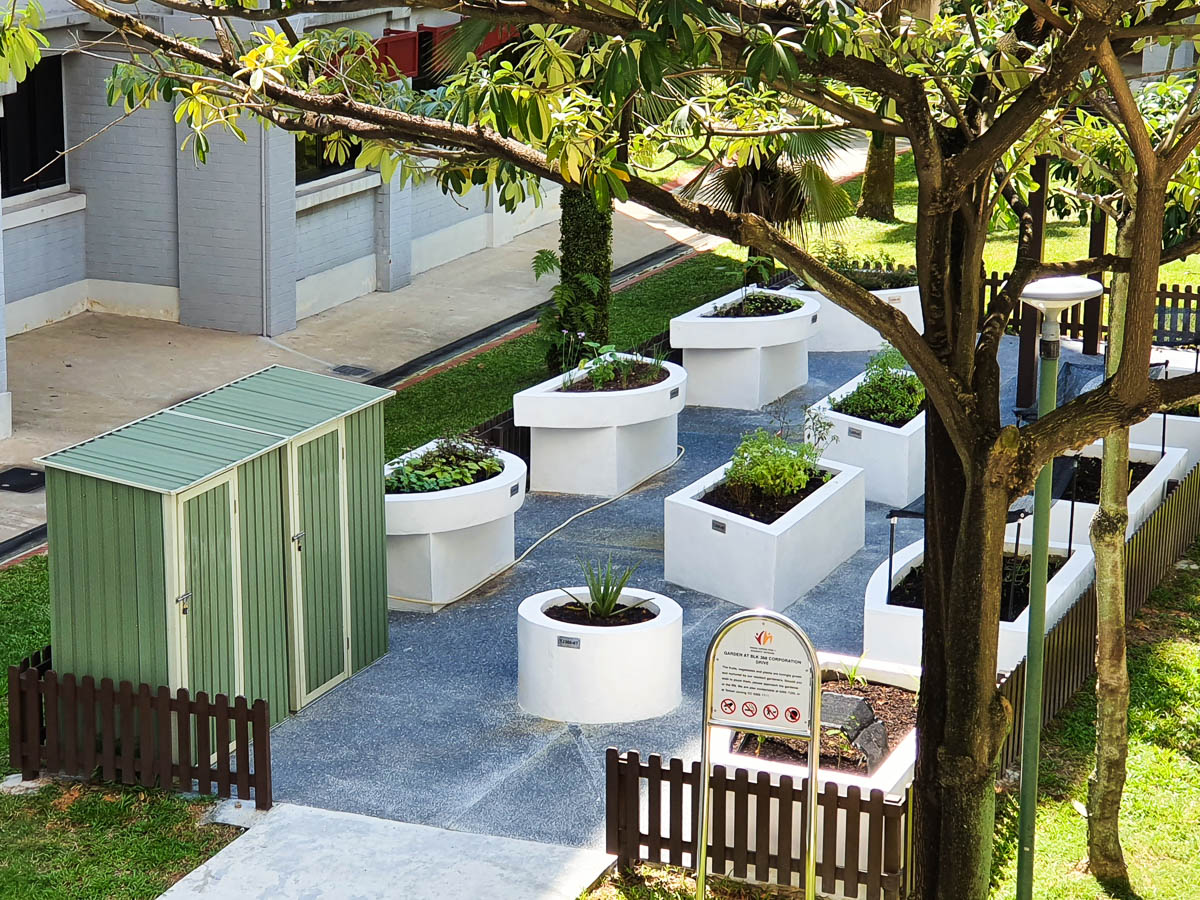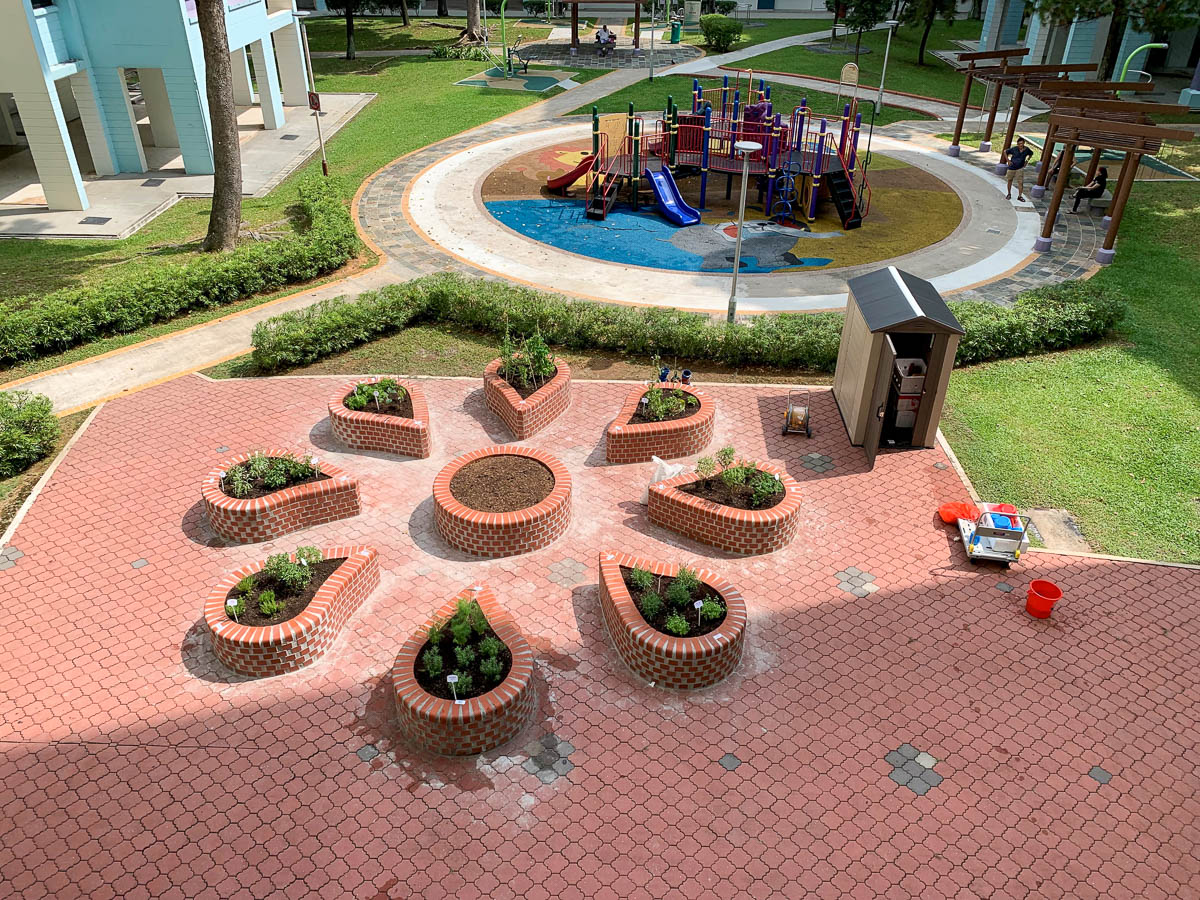Planter Beds

Planter beds are structures that hold soil above ground level. When built well, planter beds will have better drainage than true ground as they sit above the water table, making them appealing options for gardening in Singapore, which has naturally clayey and waterlogged soil. Planter beds can also be built tall enough to reduce the need for bending or squatting while gardening, or even be modified for wheelchair users to access.
Planter bed materials
Like containers, planter beds can be made from a variety of long-lasting waterproof materials. Some examples are:
-
.jpg)
Plastic, which is flexible and light. They generally last between 1-10 years, but prolonged exposure to the sun can make the brittle. Most plastic planters can be bought at plant nurseries and garden shops. Many rooftop gardens use planter beds made of PEG trays, which are modular and easy to install.
-
.jpg)
Metal, which is heavy and resilient. They last between 3-10years, but may be prone to rust if they are not coated with paint or glaze. They also tend to heat up when exposed to a lot of sunlight, which can cause plants to burn. Metal is also prone to bending outwards if the soil used is very heavy.
-
.jpg)
Wood, which can be heavy or light, but is also biodegradable and lasts between 3-5 years in the tropics, even when coated with resin and other waterproofing materials. Wooden planter beds are commonly upcycled from old bed frames, plywood and palette wood, and can give your garden a rustic look.
-
.jpg)
Concrete or brick, which can last for decades if built well. These planter beds may need annual scrubbing and painting as algae does tend to grow on the surface during the wet season. Concrete planter beds can also be cast into interesting shapes and painted to provide visual interest in a garden.
Planter bed sizes

The size of your planter bed will determine what and how much you can grow in it, along with who can access it. All planter beds should be no wider than 2m to make sure that all parts of the bed are accessible. As a rule of thumb, planter beds higher 0.9m or higher will need gardeners to stand next to it, planter beds 04m-0.7m tall are accessible for seated gardeners, and anything below 0.4m will need gardeners to squat. Determining who will use your garden and what you want to plant before you design your garden will help you decide on what planter beds are appropriate
-
.jpg)
Taller and deeper planter beds can grow larger plants and are more accessible to the elderly, but are generally more expensive to fill and build.
.jpg)
Shallow planter beds can also be raised on legs to gain the height needed for accessibility while reducing the amount of material needed to fill the bed itself. These legs can be bolted to the ground for stability or have wheels for flexibility in planter beds placement. Planter beds on legs are also more comfortable for wheelchair users as they can put their legs under the planter bed itself.
-

Planter beds can also be specially designed for wheelchair users, whether for general gardening, horticultural therapy or for ease of viewing. To make the beds accessible for wheelchair users to garden, the height of the bed must enable the wheelchair users to reach across to access the plants.
-
.jpg)
Low planter beds can have their bottom in contact with true ground, which can increase the size of the plants you can grow. If the bottom is not true ground, the size of the plants that can be grown are a lot smaller, but the bed itself will be cheaper to fill. These beds will need gardeners to squat or bend down, but are particularly accessible for children.
Managing drainage
.jpg)
Water naturally flows down, and planter beds will need some form of drainage at the bottom for water to flow out, reducing waterlogging, root rot and the collection of stagnant water.

Drainage layers at the bottom of your planter beds in true ground are traditionally made of stones or other inorganic soil amendments mixed with or on top of true ground, but many planter beds in urban areas use drainage cells and geotextile that leads to an outlet to keep water flowing out.
Filling planter beds
.jpg)
Planter beds should ideally have loamy soil to grow a wide range of plants. The soil used to fill planter beds can also be easily enriched with fertilisers and additional organic matter, making it easier to work with than true ground.
_jacquelinechua.jpg)
However, like in containers, soil will compress and compact over time as the organic matter in it decomposes, especially if it is left exposed to wind, rain and sun for long periods of time. This will look like your soil level is “sinking” down into your planter bed. Top up your soil occasionally with more loamy soil, or mix in more organic matter to refresh it.
The depth of soil in your planter bed will determine the kind of plants you can grow. Small plants like Xiao Bai Cai only need 10-15cm of soil, larger shrubs like Pagoda Flower will need 15-30cm of soil, and trees like River Tarenna and vines like Smooth Loofah will need at least 30-50cm of soil to flourish. Find out how much soil you would need to fill up your planter bed with our soil calculator!
If your planter bed is much deeper than the depth needed to grow your desired plant, you can consider filling up the bottom with well-draining filler materials to reduce the amount of soil needed to fill the bed.
You can consider these filler materials for lining the bottom of the planter beds:

- Large chunks of wood, wood chips, cocochips
- Will eventually decompose into organic material that plants can use
- Will cause the soil level to drop as decomposition takes place, and will need additional soil for topping up in a few years
- Untreated woody material may harbour millipede eggs. Take care to choose heat-treated wood, wood chips and wood compost to prevent introducing too many millipedes to your garden.
.jpg)
- Inorganic soil amendments
- Sand, stones and other large inorganic soil amendments can extend the drainage layer at the bottom of your bed
- Will not decompose and are a one-time addition
- These materials tend to be heavy, and can bend or distort planter beds made from thin sheets of metal or planks of wood if used in excess
Planter bed designs
Creative gardeners have made planter beds from all sorts of materials, and customized them to suit a wide variety of needs. Browse the gallery below to get some inspiration for planter beds of your own!

Planter beds made from brick and concrete that look like a flower when seen from above.
.jpg)
Shallow planter beds made from upcycled pallet wood and concrete slabs.
.jpg)
Planter beds upcycled from wooden posts and oil drums.
.jpg)
Concrete planter beds that are wheelchair-accessible, with an in-built storage unit below.

PEG tray planter beds arranged in pleasing shapes on a rooftop Community Garden.

